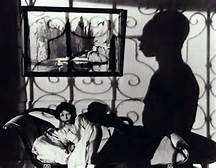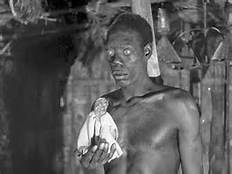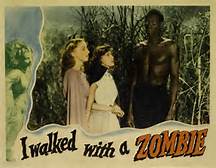(Part 1)
Lurking in Local Shadows: Rumor, Legend, Fantasy, Landscape, Twisted Religion
 When I was a boy – say eight, nine, ten – I was terrified of zombies, who always seemed involved in both mystery and the Mysteries. I had never heard of George Romero or The Night of the Living Dead (which does not employ the word “zombie”), but what I knew of zombiedom came from Weird Tales, Val Lutens’ somewhat confusing but brilliantly atmospheric and resonant film I Walked with a Zombie (1943) and stories, quips and recipes from local ancients like Granny Johnson, who was said to be half Choctaw and who seemed to keep all summer in the eave of her stoop a gigantic web with a writing spider which could stop your heart if it ever spelled your name. That was gospel in our gang. We occupied an atmosphere of superstition – witchcraft, Haitian voudoun, séance foolishness, ghost stories even at church camp and actual peculiar and violent misbehavior in our local haunts and news reports. Blood and secrecy, titillation and genuine menace. Mask societies and Brotherhoods, even. Adults thickened the broth, seeming to delight in exaggeration, insinuation and misdirection, and I suspect some of the local sense of the spooky was summoned in rebellious and contrary minds as counterpoint to the zealous ubiquity of the foot-washing, amen-shouting, Bible-smacking, full-immersion Baptist churches in East Griffin, from Faith to First Sure to Devotee, from Praise out by the Pomona peach orchards to Blood of the Lamb near the rumored Rebel supply depot from way back when.
When I was a boy – say eight, nine, ten – I was terrified of zombies, who always seemed involved in both mystery and the Mysteries. I had never heard of George Romero or The Night of the Living Dead (which does not employ the word “zombie”), but what I knew of zombiedom came from Weird Tales, Val Lutens’ somewhat confusing but brilliantly atmospheric and resonant film I Walked with a Zombie (1943) and stories, quips and recipes from local ancients like Granny Johnson, who was said to be half Choctaw and who seemed to keep all summer in the eave of her stoop a gigantic web with a writing spider which could stop your heart if it ever spelled your name. That was gospel in our gang. We occupied an atmosphere of superstition – witchcraft, Haitian voudoun, séance foolishness, ghost stories even at church camp and actual peculiar and violent misbehavior in our local haunts and news reports. Blood and secrecy, titillation and genuine menace. Mask societies and Brotherhoods, even. Adults thickened the broth, seeming to delight in exaggeration, insinuation and misdirection, and I suspect some of the local sense of the spooky was summoned in rebellious and contrary minds as counterpoint to the zealous ubiquity of the foot-washing, amen-shouting, Bible-smacking, full-immersion Baptist churches in East Griffin, from Faith to First Sure to Devotee, from Praise out by the Pomona peach orchards to Blood of the Lamb near the rumored Rebel supply depot from way back when.
These days I understand that current zombiephiles, in contrast, are actually delighted to observe gouge and gash and grue and not one iota in fear for their life forces. It’s all about creatures that have to be killed with the fervor of video game zapping. I suppose TV has a lot to answer for there, but the aficionados enjoy dressing and painting themselves as the half-mutilated brain gobblers that lurch forward on the flatscreen like Karlof’s mummy or Frankenmonster. A kind of teen Halloween festival scenario. Zombiefans sometimes maintain that they have a serious intellectual interest in matters apocalyptic, pandemic and allegorical, as well as all manner of natural and human-generated catastrophes. A fair few may be shaking off Thanksgiving lethargy by compiling zombie bibliographies or writing zombie musicals and watching Znation marathons, IZombie, The Walking Dead. I suppose hobbies are healthy.
 And I don’t begrudge these operatives in the zombie industry their diligence or their fun and fancy, except when they turn evangelist on me and suggest that, if I’d just read the right zombie masterpieces, I’d be stunned, converted and elated by the authors’ ingenuity and the emotional depth of their characters. I just hope they don’t mind my conviction that they’re playing a game, a faddish and profitable one right now, and a pretty standard academic band-wagon ploy, but not one that leads to a lot of new discoveries about their personal morality, aesthetics, metaphysics or sense of humor. Or human nature. They’re engaged in an extreme version of “making believe”; whereas, my running mates out East McIntosh Road and I actually believed, even if we harbored a flicker of optimistic skepticism. If we found pinned to a skinned willow limb by the tractor shed a snake slough with red thread twisted through it, we’d run back to the house and write Jesus’ name in a dish of salt, while reciting the Twenty-third Psalm, or some such dubious ceremony. “Dubious” I say, but I still have my fetishes, including an agated cow tooth, an arrowhead and a dove wishbone I kept in a Hav-a-Tampa box under my bed for years to ward off something or other.
And I don’t begrudge these operatives in the zombie industry their diligence or their fun and fancy, except when they turn evangelist on me and suggest that, if I’d just read the right zombie masterpieces, I’d be stunned, converted and elated by the authors’ ingenuity and the emotional depth of their characters. I just hope they don’t mind my conviction that they’re playing a game, a faddish and profitable one right now, and a pretty standard academic band-wagon ploy, but not one that leads to a lot of new discoveries about their personal morality, aesthetics, metaphysics or sense of humor. Or human nature. They’re engaged in an extreme version of “making believe”; whereas, my running mates out East McIntosh Road and I actually believed, even if we harbored a flicker of optimistic skepticism. If we found pinned to a skinned willow limb by the tractor shed a snake slough with red thread twisted through it, we’d run back to the house and write Jesus’ name in a dish of salt, while reciting the Twenty-third Psalm, or some such dubious ceremony. “Dubious” I say, but I still have my fetishes, including an agated cow tooth, an arrowhead and a dove wishbone I kept in a Hav-a-Tampa box under my bed for years to ward off something or other.
By clinging to those old days of the fifties, I suspect I’m playing a game, too, but it was no game when I was a shirtless rube in Georgia and then N.C., trusting in much of the jumble I heard about the voodoo religion, which is the bridge across which “zombie” crossed into our mainstream culture. I at least half believed in spells and starlit meetings in the deep woods, Hand of Glory, chicken blood slung about, sweaty priestesses and conjure men in top hats and spats, herbs and needles and chants, all that stuff later appropriated to lend Angel Heart the whiff of authenticity. I believed in the menacing – silent, distant, Other! – Sally Soapsuds, a kind of traiteur she-demon who lived local, just across the deep railroad cut beyond the pine farm, a crabbed and balding crone, as my running mates and I constructed her, who would castrate misbehaving little boys with a corn knife, then use their severed parts in a recipe for coarse soap.
Crazy, I know, and we were a long way from flores por los muertes in Streetcar, Marie Laveau, Anansi and their ilk or the islands where Papa Legba and Baron Samdhi held court. My friends and I were both projecting and patching together an Outsider, an Inexplicable from what mischievous elders told us and what our rancid imaginations could summon, but the fear had real voltage of a sort that current zombiemania lacks. We were trying to figure out who we were, amid school learning, church learning and the wild magic of the woods. The possibility of identity theft and the loss of all will was, we felt in our marrow, a real threat. We had all the heebie-jeebies of Tom Sawyer in the boneyard, but little of his bluster. And after all, it had to do with the devil, or The Devil, but we weren’t quite certain how.
You see, those old fashioned zombies didn’t come to us as battalions to besiege and attack like Tolkien’s (and Peter Jackson’s) orc hordes. They came as single spies, rattling doorknobs, red-eyed, their bodies whispering against the cornstalks, spells (maybe in Cajun French, which we’d hardly even recognize) on their tongues as they moved with unimaginable stealth and malice aforethought. They slid through ground fog and mire ooze and from one flare of foxfire and swamp gas to the next. They were alternately secretive and brazen, and they did not want to eat our (my!) brains. They wanted our souls, servitude, renunciation of the light. There was a metaphysic in operation here, a spiritual issue, not any junk-science epidemiology (which I’ve researched just enough to equate with mail order ads in the back of comic magazines); perhaps more junk-blasphemy. The zombies of old were to us more like eidolons or ghost riders than monsters, and with them came all the terrifying allure of the occult, all the more threatening because preachers had made it clear that even we “innocents” probably had Dark Hearts. Maybe we were in some ways unconsciously seeking thrill, but the impact was less intellectual than visceral, and if we were being entertained, it was not in a way we recognized. If we sought out the images and texts that sent a jolt of fear through us, it was because we were mindful of my grandmother’s advice against trusting the ignorance-bliss equation. “It’s best to know what’s out there,” she said almost daily, in a whisper.
 So much for the local ingredients. I also read Weird Tales, in which the neo-Lovecrafts, as well as some original and transgressive writers, cut their teeth. Werewolves, mummies, deranged dentists, leopard men, escaped lunatics, sachems, Creole conjures, aliens and urban ghouls – it was all fodder for the pages of that thrill-chill publication. And my friends and I composed some stories ourselves, with “The Monkey’s Paw,” “Lygeia” and “The Open Window” as our guides. After all, what was on the page in the daylight twenty-six letters we could participate in, imitate, join. Today it’s called “fan fiction” when it’s not being labeled Young Adult fiction. But we could not similarly master the abandoned barns, brier yards, snaky woods, rotting timber mills, ghost slave narratives told around campfires, runes and bone shards and ideograms, the “Colonel’s Lights” that flickered on the distant hills, then vanished. Daytime school was beginning to teach us to examine the English language, trace the motives, learn how the narratives worked. But the local spoken word, with all its slang and syrupy syllables, was different: anybody who gave voice to the exotic folkloric shiver-and-boo stories (even when we did it ourselves) was in part aiming to further mystify, to thicken the soup, or whatever was bubbling in Sally’s cauldron. And the young imagination newly hazed with testosterone could be a fertile field.
So much for the local ingredients. I also read Weird Tales, in which the neo-Lovecrafts, as well as some original and transgressive writers, cut their teeth. Werewolves, mummies, deranged dentists, leopard men, escaped lunatics, sachems, Creole conjures, aliens and urban ghouls – it was all fodder for the pages of that thrill-chill publication. And my friends and I composed some stories ourselves, with “The Monkey’s Paw,” “Lygeia” and “The Open Window” as our guides. After all, what was on the page in the daylight twenty-six letters we could participate in, imitate, join. Today it’s called “fan fiction” when it’s not being labeled Young Adult fiction. But we could not similarly master the abandoned barns, brier yards, snaky woods, rotting timber mills, ghost slave narratives told around campfires, runes and bone shards and ideograms, the “Colonel’s Lights” that flickered on the distant hills, then vanished. Daytime school was beginning to teach us to examine the English language, trace the motives, learn how the narratives worked. But the local spoken word, with all its slang and syrupy syllables, was different: anybody who gave voice to the exotic folkloric shiver-and-boo stories (even when we did it ourselves) was in part aiming to further mystify, to thicken the soup, or whatever was bubbling in Sally’s cauldron. And the young imagination newly hazed with testosterone could be a fertile field.
I can see now that our auto-neurotic embrace and conflation of the unknown, the Other, sensational crimes, the twisted way local and regional history and dogma were stored and delivered – it all depended upon some profound but almost ubiquitous misunderstandings, including a complicit but unacknowledged racism, and I want to return to this next week in Part Two, when I focus specifically on Val Lewton’s zombie movie, which also presents the entanglement of cursing and curing in voodoo, twisted together with a metaphysical battle (similar to vampirism’s crucifix-and-holy-water vs. fang-and-dark-heart dynamic) that is steeped in Catholic imagery, some of which had hold of us, though we didn’t get it at prayer meeting. The story also involves impossible-to-ignore conflicts across social classes and between rural and settlement dwellers, as much as between descendants of slaves and descendants of the “gentry” who owned plantations or took wages from those who did, people who, at least legally, owned humans as if they, too, were property. Also, that gentry’s complacent minions. History told us it was blood-soaked ground, and folklore concurred. It may have all been somewhat exciting, as well as terrifying, but it wasn’t fun.
Next Week: I Walked with a Zombie (or A Canadian Jane Eyre Voyages to St. Sebastian Island, Is Smitten with an Unwidowed Sugar Planter, Ministers to the Undead and Witnesses Strange Rites Amid Whispers of Stranger Wrongs, All Without Mussing Her Coiffure – Also a Scary Sword Trance Dance out Where the Wild Things Lurk)

